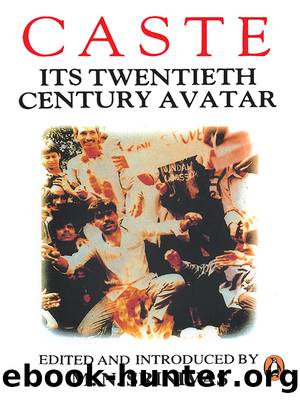Caste by M N Srinivas

Author:M N Srinivas [Srinivas, M. N.]
Language: eng
Format: epub
ISBN: 9789351187837
Publisher: Penguin Books Ltd
Published: 2014-08-22T00:00:00+00:00
Buddhism and Its Impact: The Prevailing Urban Perspective
A commonly held view on the impact of the conversion to Buddhism is that it has led to a great psychological release for the former Untouchables. This view is particularly endorsed by Zelliot (1977: 133, 137-138), whose evidence is based on interviews with some Dalit leaders. She emphasizes this point and refers to the impact of conversion in the following way: âContemporary observers report a general elation among the Mahar community â a sudden sense of psychological freedom among students, a gallant mood in the villages, a ceremonious discarding of god images in the river, a pious closing of the home-brew stills in the slums of Bombay.â She goes so far as to suggest that the psychological impact of Buddhism and the effect of the new identity can best be gauged from Buddhist literature, writings and songs. She cites a song written by Waman Kardak, a Buddhist singer, as epitomizing the feeling of psychological release. Developing her argument, she quotes a Dalit writer, Gangadhar Pantavane, as saying: âBhimrao (Ambedkar) has placed us in the lap of a life-giving religion and so has awakened psychological independence.... This is the religion of Gautam, who with love won the world, and the spine of this religion is humanity.â According to Zelliot, âFor Waman Kardak, an uneducated but highly skilled and professional performer, and for Gangadhar Pantavane, a Professor of Marathi in Milind College and a writer and an editor, the profoundly satisfying psychological meaning of the conversion is clear.â
Eleanor Zelliot (1966b: 205) coined the term âpali-izationâ with reference to the conversion of Mahars to Buddhism. Says Zelliot, The conversion continues the âpurifying processâ that has been part of the movement all along, a âPali-izationâ rather than a âSansksritizationâ of practices, to use the Buddhist equivalent for M. N. Srimvasâ useful word for the emulation of high caste practices.â She emphasizes (ibid.) in no uncertain terms that âthe conversion was accompanied by the throwing out of the Hindu gods from the Maharwada...â. Sunanda Patwardhan (1973: 153), another sociologist, shares the same views.
Zelliotâs observations are also endorsed by yet another sociologist, Jayshree Gokhale-Turner. In an unpublished paper, she reiterates the theme of, and emphasizes the aspect of the Maharsâ pride in Buddhism. 3
Owen Lynch, probably the most perceptive amongst the sociologists dealing with this issue, while studying the conversion of the Jatavas of Agra to Buddhism, has a different perspective. He describes Dr Ambedkarâs conversion movement as âsaintly politiesâ. Says Lynch ([1969] 1974: 143), âAmbedkar well knew that religion was suffused into every nook and cranny of Indian society and that the mind of the masses had not yet learned to distinguish that which is Caesarâs from that which is Godâs. He therefore turned to âreligioficationâ â the art of turning practical purposes into holy causes. Buddhism is a political religion which the Jatav masses can respond to. It pours the new wine of political modernity into the old bottles of religious tradition. It was a stroke of
Download
This site does not store any files on its server. We only index and link to content provided by other sites. Please contact the content providers to delete copyright contents if any and email us, we'll remove relevant links or contents immediately.
| Diaries & Journals | Essays |
| Letters | Speeches |
The Rules Do Not Apply by Ariel Levy(4842)
Bluets by Maggie Nelson(4472)
Too Much and Not the Mood by Durga Chew-Bose(4270)
Pre-Suasion: A Revolutionary Way to Influence and Persuade by Robert Cialdini(4142)
The Motorcycle Diaries by Ernesto Che Guevara(4009)
Walking by Henry David Thoreau(3892)
Schaum's Quick Guide to Writing Great Short Stories by Margaret Lucke(3317)
What If This Were Enough? by Heather Havrilesky(3270)
The Daily Stoic by Holiday Ryan & Hanselman Stephen(3228)
The Day I Stopped Drinking Milk by Sudha Murty(3159)
The Social Psychology of Inequality by Unknown(2935)
Why I Write by George Orwell(2874)
Letters From a Stoic by Seneca(2733)
A Short History of Nearly Everything by Bryson Bill(2627)
A Burst of Light by Audre Lorde(2545)
Insomniac City by Bill Hayes(2494)
Feel Free by Zadie Smith(2433)
Upstream by Mary Oliver(2337)
Miami by Joan Didion(2321)
